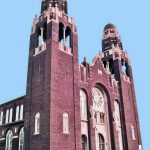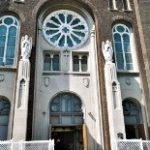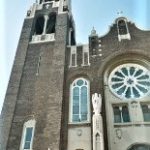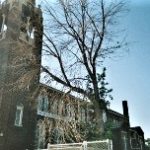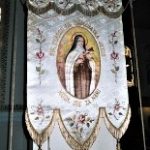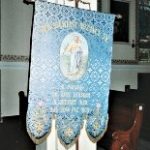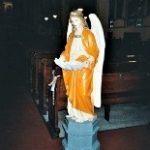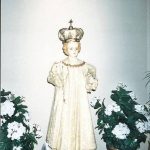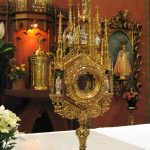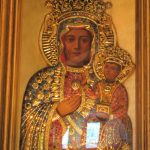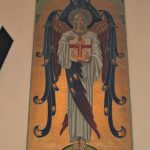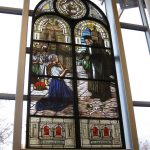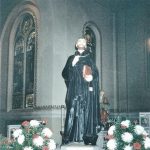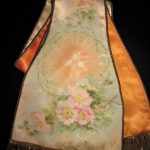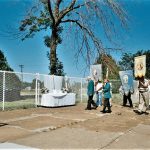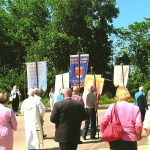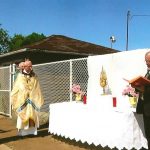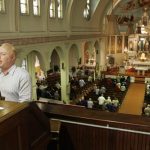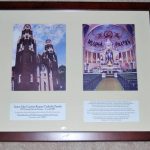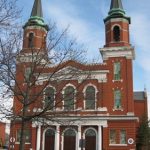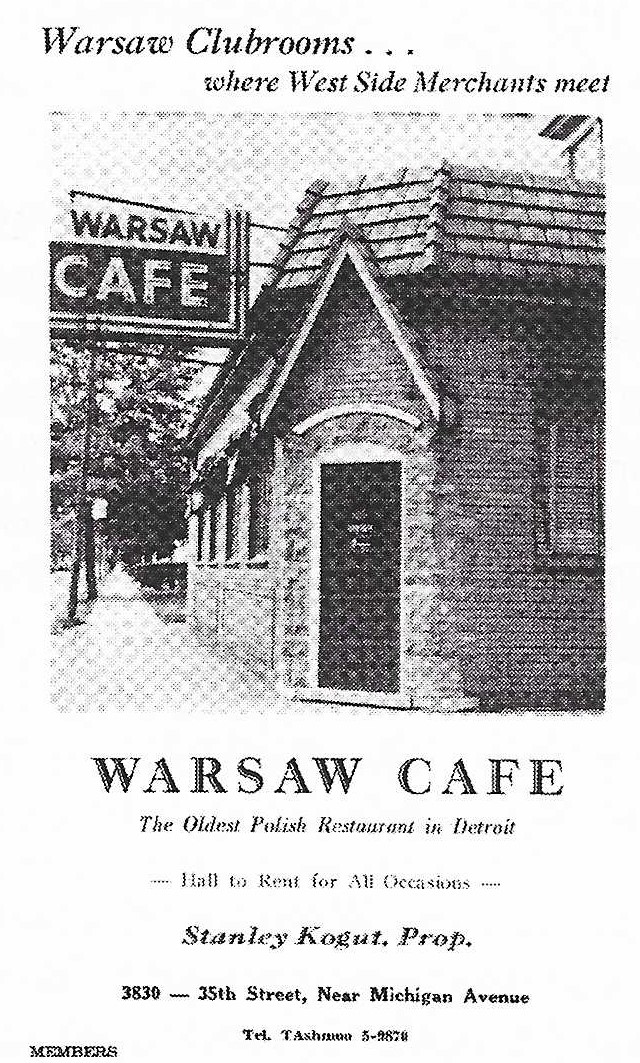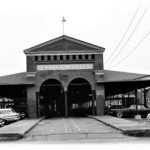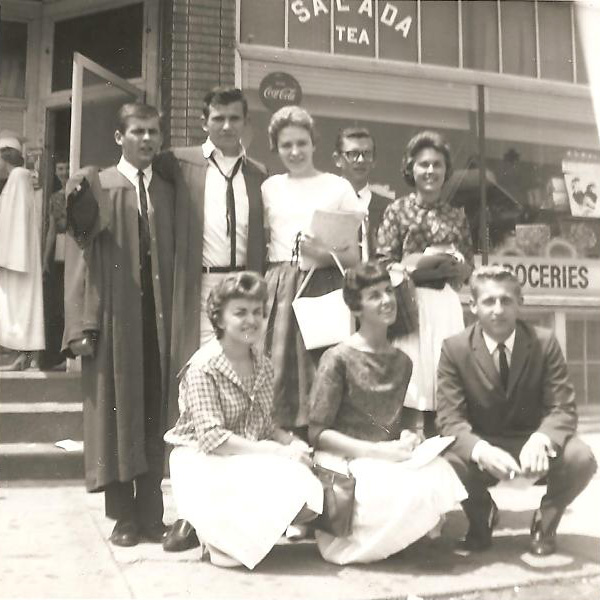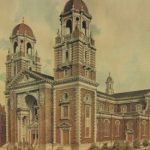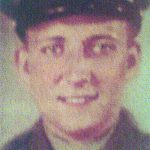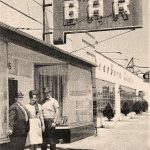Part 1 | Part 2
“Blessed Memories Of St. John Cantius”
By WSDPAHS Honorary Member and
St. John Cantius Organist Steven Frayer
Copyright © 2020 Steven Frayer
Reprinted with Permission
Part 1: The Beginning
I started my position as organist at St. John Cantius on Saturday, February 20, 1993. On that date, I also started my church musical career. I came to Southwest Detroit to visit my grandparents for a long weekend in January. They were both very ill; my grandmother was in hospice care, and my grandfather would be diagnosed with colon cancer in March of that year. My grandparents asked me to stay with them, and I agreed. I was in between jobs but wanted to find something to do while I was living with them. I needed something that would enable me to be with them during the week when I was needed, so I decided to look for organist positions within the Archdiocese of Detroit.
In those days, of course, there was no Internet or cell phones. Today, one can visit the Archdiocesan website and can see which churches are hiring church musicians. But back then, I had to either call or write to the Archdiocesan Department of Parish Life and request a list of what parishes were hiring. I was sent a listing, and there were two parishes that caught my attention: St. Louis the King located on 7 Mile and Mound on the east side of Detroit, and St. John Cantius. I had heard about both parishes; my grandfather worked at Holy Cross Hospital on Van Dyke and East Outer Drive and had mentioned St. Louis from time to time. My mother was friends with the secretary at St. John Cantius, Irene Pilch. Irene also worked as secretary at St. Andrew School located on Cecil and McGraw, and my mother served as their speech therapist. There was also a family connection to St. John Cantius. My great uncle by marriage had been a lifelong parishioner there before he married my great aunt. St. Louis the King was a little too far to travel for me, so I decided to call St. John and ask for an audition.
I can’t remember the exact date that I called, but I did speak to Rev. Edwin Szczygiel, who was the pastor there, and who had been the pastor at St. John Cantius since 1968. I was told that if I wanted to audition to come play for the 4 PM Mass on Saturday, February 20, 1993. I thanked Fr. Szczygiel and we hung up. I was a bit intimidated because he seemed a little gruff, but I wanted the job, so I decided to go for it. If it wasn’t meant to be, it wasn’t meant to be. My grandfather wanted to go with me, and we made the 10-minute drive from my grandparents’ house on Larkins to Delray.
I remember how deserted that part of Southwest Detroit was, and my grandfather told me as we drove how vibrant it used to be, with the residents being mostly Hungarian immigrants and families on one side of the tracks, and then Polish immigrants and families on the other side of the tracks. And then, out of all this desolation, St. John Cantius suddenly appeared out of nowhere. Majestic and beautiful, it stood facing the Detroit Wastewater Treatment Plant. I remember feeling saddened about that, especially when I learned that houses had been razed to make room for the building of the plant. The inside of the church was absolutely magnificent.
Fr. Szczygiel—oh, how to describe him? Sometimes gruff, sometimes rough around the edges, but a nice guy who absolutely didn’t mince words. He was waiting for me in the vestibule of the church. So I sat down with him and he asked me right off the bat, “Are you Steve, you’re the organist today, right?” I answered that I was, and he asked me then, “You want the job for steady?” I was floored and stammered, “Well, yes, but don’t you want me to audition first?” He answered, “I trust you. If you came here, you should know what you’re doing. Salary is $450 per month, which works out to be $37.50 per Mass. Funerals are $75, weddings are $100. Any questions?”
I remember being absolutely shocked with the swiftness of this whole transaction/job description and then he said, “Well, you better get moving, the organ is straight up there.” He pointed upwards, got up from his seat, and went to get ready for Mass.
With my head spinning, I climbed the eight flights of stairs to the choir loft. There was a Kilgen organ seated in the middle of the choir loft and it looked a little nondescript. But when I turned it on, you could hear this huge motor start and the bellows fill up with air. The entrance hymn I played was “Come, Christians, Join to Sing,” and the organ just sang triumphantly. I was the organist at St. John Cantius in Detroit. I was both proud and shocked at the same time. To this day, I’ve never been on a job interview that was so swift!
Part 2: The Parishioners and Daily Life of St. John Cantius
Once I got settled in at St. John Cantius, life settled into a comfortable routine. The Mass schedule was as follows: I was responsible for the music for three Masses per weekend. There was a Mass at 4 PM on Saturday, a Mass at 9 AM on Sunday, and a Mass at 12 noon on Sunday. The Mass at 4 PM on Saturday was always the best attended, as was the Mass at noon on Sunday. The Mass at 9 AM on Sunday was the least attended, and once a month—usually the first Sunday of the month—the 9 AM Mass was in Polish. Luckily, I was raised knowing many of the hymns that were necessary for the Polish Mass. My mother had sung in the choir for her home parish of St. Stephen Catholic Church on Central Avenue, and she (and her family) sang many of those hymns often. Thus, I grew up having at least some knowledge of Polish hymns.
Shortly after starting at St. John, I started playing Polish hymns as a meditation after Communion. I remember the congregation being really surprised, and they’d sing along, which made me feel good. I really enjoyed my job there. It was fun, and it was a great creative outlet for me.
The staff at St. John Cantius at that time was Fr. Szczygiel, the secretary was Irene Pilch, and the janitor was a Hungarian immigrant named Imré Balázs, Jr. Imré was from Holy Cross Hungarian Church located around the block on South Street, and his wife was the housekeeper there. His parents also lived in the neighborhood. Irene Pilch was another powerhouse at St. John Cantius, and she kept things running like a well-oiled machine. She knew my mom from their days at St. Andrew School, and so I had a friend right away there at the parish. Her husband Ed, brother-in-law Richard, and her in-laws, Peter and Bernice Pilch, were all extremely active in the parish, also. All of those people are of blessed memory now, but the memories of them really do live on and have for so long—Irene always had coffee and donuts in the rectory every Sunday, and I’d stop by in between Masses to chat and review anything that was coming up during the coming week. Irene kept the parish going many times when Fr. Szczygiel had been ill with a lengthy illness and was required to be gone from the parish for treatment.
Imré was a man who absolutely would do anything for you. He couldn’t speak English very well, but he absolutely would do anything. I remember him helping me fix one of my tires when I got a nail in it so I could get home, and whatever was needed, he did without question. Fr. Walter Ptak would come and many times would celebrate the Mass at noon on Sundays, and there were priests who would come from Orchard Lake St. Mary to do the Polish Mass on Sundays once a month.
My substitute organist at St. John Cantius was Eugene Murphy, who would do my funerals when I couldn’t be there. Through Eugene Murphy, I also got other musical opportunities, like playing for funerals at various parishes around Southwest Detroit. Through him I played at St. Francis d’Assisi, St. Hedwig, Our Lady Queen of Angels, and St. Stephen. I also subbed for him for a short time when he had a bad accident in 1994.
For Holy Days of obligation, the Mass schedule was 9 AM and 6 PM. I was not responsible for playing the 9 AM Mass, as it wasn’t really well attended. I was obligated to be there for the 6 PM, and that was rather well attended, from what I recall. Our church seemed to be a stop off of sorts sometimes for people who wanted to attend Mass after work on Holy Days.
Our social events at St. John Cantius included a Spring Fling dance, which was held in April, shortly after Easter, as well as a Sweetest Day dance in October. Catering was usually done by the women in the parish, but also once in a while a caterer would cook. There was dancing, too, and music was by Art Wyse and His Orchestra. On Palm Sunday, we would have a bake sale, which would take place the whole weekend after all of our Masses; and I still can taste Lottie Slowik’s placek—a type of Polish sweet pastry with raisins. I can still taste it, and the recipe went to the grave with her. I haven’t had it since those days. Those were the fundraisers at the time for the parish. More would be added later as the years progressed.
Part 3: Memorial Day, All Saints’/All Souls’ Day & Christmas
I’m pretty sure, as I reflect and write this, that I was probably one of the youngest organists in the history of St. John Cantius. When I started my career in February of 1993, I was 22 years old, turning 23 in March of that year. My predecessor, a Polish organist named Professor Chmielewski (I never found out his first name, he was just always referred to as “professor”), retired at the age of 88, and the only reason he retired was because he couldn’t climb the stairs anymore (there were eight flights of stairs leading to the choir loft). I think the people were amused that I came along, this young skinny kid who could play and sing Polish. My Polish wasn’t perfect at first, but I got the hang of things with help from the people, and so many took me under their wing, too. Parishioners would bring me food and goodies—there was a parishioner named Mary Merta, and she and her husband Chester would bring me canning jars full of soups, or cookies that she’d bake, or cakes she’d bake as well. A parishioner named Toni Balan made the best beet soup, and she and her husband brought me that regularly. I’d get chocolates at holiday time from Alina Walewski and her mother, Michaeline, and it was like I’d inherited this entire large family of Polish aunts and uncles who just wanted to look after me. My grandfather with his sweet tooth loved it, and he looked forward to Sundays all week long. So did I!
One of the big events in the parish was Memorial Day. There was a Memorial Day Mass held on Memorial Day itself with the members of the Jeep Gabrys American Legion Post 388 marching in procession while I played the Battle Hymn of the Republic. There was a service at the Veterans Memorial, which was located in between the church and the school building. Wreaths were laid at the memorial by three separate Gold Star Families in the parish, and then there was a coffee and donut reception in the social hall, which was in the basement of the school building. Gold Star Families were families who lost immediate family members in the line of duty during military service.
When November came, Masses were held for All Saints’ and All Souls’ Day, and we had evening Masses on both days, but on All Souls’ Day there was Mass with a catafalque that was covered with a funeral pall. That’s not seen very much anymore, if at all, and that was the case back then, also. Polish and English hymns were sung in memory of the deceased of the parish, and a list was read of those who had died that year. Toward the middle of November, envelopes were passed out for Christmas flower collection. When that announcement was read from the altar, I knew Christmas was coming, and soon.
Christmas at St. John Cantius was really something else, and a whole team of volunteers would, for both Christmas and Easter, spring into action like a highly organized army on maneuvers. Pews were scrubbed and polished, and massive Christmas trees were pulled up from the basement (they stood on rollers so they could be wheeled up from the basement, and they were kept completely decorated with “icicles” that covered them from top to bottom). Canvas covers were kept over them when they were taken down and put away. Those trees stood on either side of the main altar. Poinsettias covered every single surface that was available, and in the electric wall sconces that were in between the Stations of the Cross (the Stations were hand painted and were imported from Slovakia) red and green bulbs were placed. Those sconces were rarely lit, but on Christmas and during the season, they were. Wreaths were placed on every post inside the church, lights were strung along the choir loft outer wall, and exquisite altar cloths that had been hand beaded and hand sequined by the Felician Sisters were unboxed and laid on the altars. A massive nativity scene was placed on the right side of the church near the Sacred Heart altar. Our church really shone at Christmas time. It really was an amazing place to be at any holiday season, but especially at Christmas.
With Christmas approaching, it was time to start practicing the music for Pasterka, the Polish Midnight Mass. When I came to St. John Cantius, there was no choir, but a little choir would form to sing the Polish Christmas carols, or kolędy. It consisted of Irene Pilch and a few of the men and women from the parish. We’d start rehearsing about two weeks before Christmas Eve, and it came together pretty well for the limited time we had to get it together. However, these were all melodies that these folks had been singing all their lives, and I had, too. We just had to fine tune things a bit, and we were ready to roll. The Mass setting that was used at that time was all kolędy for the various parts of the Mass. That way, the people could sing from memory with very little effort. I believe a copy of that Mass, along with the song sheet used for caroling, are in the Society archives.
I had been told that the Pasterka was one of the most well-attended events in the St. John Cantius liturgical year. I didn’t exactly take that at face value because many times Masses at St. John were a shifting crowd. So, after my family celebrated our Wigilia celebrations, my grandfather, great aunt, and I made our way to St. John Cantius. My mom and her husband came, too, on a few occasions. It was dark in the church with just a few lights on in the sanctuary, but the vestibule lights were on. I didn’t expect there to be a big crowd, given the area, and I just took a “wait and see” attitude.
The way the organ was situated, my back was toward the people, and I had a mirror so I could watch the celebrant at the altar. While I played the prelude I could hear doors downstairs in the sanctuary opening and closing, people coming in and getting situated, wooden pews creaking, people whispering, “Merry Christmas” or Wesołych Świąt, and flashes from cameras going off—basically, the sounds of a church starting to fill.
Around 11:30, the choir gave me the signal that the caroling should start. We always started with the Polish carol Anioł pasterzom mówił, which translates to “The Angel Said to the Shepherds.” I always chose to start with that one because it is one of the oldest Polish kolędy written down. So I played the introduction, and the choir started. I could hear people down below singing, and I mean they were REALLY singing. But I couldn’t see much because besides the lights in the choir loft and those coming from the vestibule, the church was dark, and the more I played and the more the choir sang, the more the people sang. So I’d play a couple of carols and kolędy, and then we’d take a bit of a break, then I’d play something in English, then in Polish, then maybe Latin, until about 11:55 or so, and then we would stop so people could prepare themselves for Mass.
At midnight—and I do mean MIDNIGHT and not 12:05—I was given the signal to start the processional. The processional was always Pójdżmy wszyscy do stajenki, as Fr. Szczygiel carried the Christ Child to the manger. After that, Irene Pilch would sing “Silent Night/Cicha noc,” and after the Christ Child was placed in the manger, the lights came up. I looked behind me and was amazed—the church, this church that in many ways stood at the end of nowhere, was packed. People were in pews, standing along the sides and back, there were people standing in the vestibule, folding chairs also had been set up for those who couldn’t stand. I mean, there were people EVERYWHERE. In later years, people would even come up to the choir loft to sit. The church was absolutely packed. I couldn’t believe how incredible that was—and the people sang with one voice. It was and remains one of the most phenomenal experiences I’ve ever had as a musician.
Our hymn lineup for Pasterka was as follows:
Processional Hymns: Pódżmy wszyscy do stajenki (Irene Pilch)
Placing of Christ Child in Manger: Silent Night/Cicha noc (Irene Pilch)
Offertory: Śliczna panienka (I would solo, or ladies would—it changed from time to time)
Communion: Lulajże Jezuniu
Communion Meditation: O Holy Night (Solo by Irene Pilch)
Closing Hymns: Joy to the World and Cieszmy się i pod niebiosy
Part 4: Easter
I believe that it was St. John Chrysostom who said, “Easter is the Queen of Feasts,” and St. John Cantius prepared for the arrival of royalty with great anticipation. Lenten devotions included Stations of the Cross and Gorzkie żale (the Polish passion lamentations). These devotions were held on Wednesday evenings, and they alternated. One week would be Stations of the Cross, and the other would be Gorzkie żale.
Palm Sunday would be celebrated with the Mass, and then afterward there would be the church’s Easter bake sale. So many ladies and gentlemen baked and donated, and the church hall smelled absolutely incredible. As I’ve said before, there was a parishioner named Lottie Slowik who made the best placek, a type of Polish pastry that was covered with raisins. I can still taste it, as well as many of the other pastries that were donated.
During Holy Week, the parish had its annual parish retreat, which was held in Polish and English. We celebrated the Mass of the Lord’s Supper on Holy Thursday and the Liturgy of the Passion on Good Friday. The church was usually open for private prayer until early evening, and then decorating for Easter started immediately after that.
Boxes and boxes of spring flowers lined the back sacristy. Pots of lilies stood at attention along the back hallway that connected one sacristy, and daffodils and hyacinths were among them. Again, an army of volunteers sprang into action to make sure that the church absolutely gleamed to welcome Easter. Men placed pots of Easter flowers on the magnificent main altar. There’d be men standing in front of the altar passing flowers to men in their stocking feet walking along the upper portion of the altar. In short, every single surface, as at Christmas, was covered with lilies, hyacinths, daffodils, and tulips. Parishioners were most generous at that time of the year.
The grave of Christ stood to the right of the main altar as one walked in. The entire church smelled of spring, freshness, and rebirth. It totally gleamed.
Święconka, or blessing of Easter baskets, usually took place at noon on Holy Saturday. Later that evening was the Easter Vigil with blessing of fire, water, and so forth. But the pièce de résistance was our Rezurekcja (Resurrection) Mass on Easter Sunday.
Usually, a proper Rezurekcja takes place very early in the morning. Ours took place at 8:30 AM and would start with Fr. Szczygiel walking to the tomb of Christ and kneeling in prayer. He then would bless it and pull a white sheet over the image of Christ lying in repose located in the grave. Afterward, he’d intone the Polish processional hymn Wesoły nam dzień dziś nastał, and that was my signal to start the procession.
After Fr. Szczygiel intoned the opening stanza of the Polish Easter hymn Wesoły nam dzień dziś nastał, the procession started. Under a canopy held by the ushers, Fr. Szczygiel, in gold vestment, held the monstrance containing the Blessed Sacrament. It moved to the right, past the main altar, past the Marian altar and down to the far side aisle, then up the side aisle near the stained glass windows, past the front of the church to the other side aisle, up near the Sacred Heart altar past the empty tomb, in front of the main altar again, down the main aisle, and so forth. This happened three times. I can remember that wonderful organ, too—this mighty Kilgen organ that absolutely thundered out in celebration of Christ’s triumph over death. The people were on their feet singing, the scent of spring flowers permeating the air, the smell of incense. There was an excitement, rejoicing, and the complete joy was absolute. The procession ended at the main altar where the people were blessed with the Blessed Sacrament. The music for the Easter Rezurekcja was Easter hymns, and like Christmas, where kolędy were used as Mass parts, the same held true for this Easter Mass. After Mass, people greeted each other with, “Happy Easter!” and “Wesołego Alleluja!” Such a special time at such a special place.
Part 5: Weddings
In the summer of 1993, Fr. Szczygiel was diagnosed with colon cancer and had to have an operation to remove a tumor on his colon. Right about that time, I was to play for my first wedding at St. John Cantius. A young couple came up to the choir loft to meet with me about music. They were to be married in September, and since Fr. Szczygiel couldn’t perform the wedding due to health, Fr. Dan Trapp, who was at that time the pastor of All Saints Parish on Fort Street—less than five minutes away—was going to do the nuptials. Cindy and Mark, the couple, were going to have 10 attendants each, so there was a total of 20 people standing up to this wedding. The church was packed with people, and the music chosen for the procession of attendants was Clarke’s Trumpet Voluntary, and I remember losing count as I repeated the piece over and over as people processed down the aisle. Weddings usually were at 2 in the afternoon, and Fr. Szczygiel would tell the bridal couple and the attendants that his organist started playing right at 2—so they were to have their gowns and headpieces in place, guys were to be lined up and ready to go, and that was that. Needless to say, we started on time—every time.
Part 6: The Finale
In August of 1995, following a family wedding, my grandfather became seriously ill. In early September, he was diagnosed with kidney cancer. I was caring for him and playing at St. John Cantius, plus I was working full time as well, but I kept on so I could care for him properly. In late 1996, he had a very bad fall. Shortly after that, while I was getting him dressed to go to church, I noticed an egg-sized lump right below his shoulder. He half smiled and said, “That’s cancer, it’s spread.” And indeed, it had—to his bone. In a very short time, my grandfather was completely bedridden, so I needed to be at home with him, and in February of 1997, I left St. John Cantius—ironically, the same month that I had started. The people were very upset, but family to me comes first, and my grandfather needed me at home more. I had also promised my grandmother that I would care for him before her death four years earlier.
I am very glad that I did that because his condition grew worse. The cancer had destroyed his hip, and shortly before Mother’s Day in 1997, he was admitted to the hospital for hip replacement surgery. On May 18, 1997, I visited him and he told me not to be sad or upset, that he had a good life and if it was his time, it was his time. Later that evening, my grandfather died rather unexpectedly of a sudden asthmatic attack.
I was completely devastated and remained that way for the remainder of that year and for several years afterward. I did go back to playing music, working for several churches in the meantime. I worked at St. Stephen Church on Central Avenue, then St. Barbara Church in East Dearborn. I also interviewed at a few parishes as well, like Sweetest Heart of Mary, Transfiguration, St. Ladislaus in Hamtramck, and St. Hedwig. Later on, I went to work at Holy Cross Hungarian (where I still am), and Ss. Andrew & Benedict, the daughter church of St. John Cantius, but I always had hoped to go back to St. John’s. My heart was there.
In February of 2002, Fr. Szczygiel died after a brief illness, and Fr. Ed Zaorski became the parish administrator and then the pastor. Fr. Ed was the pastor of All Saints Parish on Fort Street, and Ss. Andrew & Benedict Parish on Beatrice Street on the far side of Detroit’s Southwest area. So St. John Cantius was clustered with those parishes.
In November of 2004, while at a parish dinner at Holy Cross, Fr. Ed came and told me that their organist had left, would I want to come back, and I readily agreed. So on Saturday, November 20, 2004, I returned to St. John’s to play the Vigil Mass for the Feast of Christ the King. I was so happy to be back, and it was a good three more years that I spent there, again, playing for parish Masses and devotions. I enjoyed being clustered with the other two parishes, also—I had made friends at All Saints, and it was fun collaborating with the music ministers from both parishes for holidays and such. I learned a lot and I hoped that I taught them things as well.
The demographic at St. John Cantius had changed, and the parish community had dwindled quite a bit since I left in 1997. The church continued on, however, slowly, but it did. St. John Cantius had brought back the Corpus Christi procession as well, and that was a much anticipated event in those last years, also.
One morning in late summer 2005, I received a phone call from Irene Pilch that woke me out of a sound sleep. The school building, in whose basement hall all the church’s dinners and social events were held, had burned due to faulty wiring in the basement. That event sort of signaled the end of St. John Cantius. The school was demolished in mid-2006. In late 2006, the Archdiocese of Detroit undertook a project that identified which churches were viable and which were not. I got a phone call again from Irene that we were slated for closure.
When we received those words, the parish council had a meeting, and we were told that at that time the parish had only enough money in its account to be able to accommodate one major emergency, so if the furnace went, or whatever, that would be it. We decided to take the Archdiocese’s advice and prepared to close—but we were going to close with dignity and were going to have a year’s worth of celebrations to honor the life and spirit of this church that for over a century was the pinnacle and strength of the Poles that came to and from Delray.
So we had different celebrations to honor the life of the parish. That led us right up to the closing that was scheduled on October 28, 2007. I got to work planning the final Mass. Fr. Ed wanted it to be a celebration, and a hopeful one that celebrated the immense heritage and history that the parish was leaving behind. The music was done by me and the combined choirs of All Saints Parish and Ss. Andrew & Benedict. And, as anticipated, the church was filled to capacity, with people standing in the aisles, vestibule, and outside.
The Mass was concelebrated by Auxiliary Bishop John Quinn and Auxiliary Bishop Daniel Flores. Fr. Ed Zaorski was the homilist, and there were many other priests and Felician Sisters (who had ministered at the school) in attendance. It was a very emotional day, and it was made even more emotional during parts of the Mass where individual people came up to kiss the altar, and then right before the very end, we had a tribute to the church’s image of Our Lady of Częstochowa. I wanted that to be similar to the unveiling and veiling of the image in Poland, so I played and sang the Polish hymn Zapada zmrok, a hymn that describes the coming of evening and saying goodnight to Our Lady. After the English translation was read by Sr. Rose Marie Kujawa, CSSF, Ph.D., then-president of Madonna University in Livonia, the image was veiled.
Our reception following the Mass was held at The Grecian Center in Southgate, and a few days later, the staff gathered at St. John’s to help remove articles that were going to other parishes, turn in our keys, and so forth. St. John had passed into the annals of history.
I was very blessed, and consider myself very blessed, to have been part of the staff of this parish. It was the best place for a budding musician to have started, and I learned a lot—not only about parish music in general, but also about my Polish heritage. I was blessed that I answered St. John’s call for an organist. Absolutely beautiful memories have stemmed from this church that stood at the edge of nowhere.
I still play in Delray. I play for Holy Cross Hungarian Catholic Church on South Street for the English Mass, but sometimes I help at the Hungarian Mass, too. Holy Cross is just a block away from where St. John’s building stands, so I still see it every weekend. The church building still looks pretty much the same. Holy Cross and its parishioners are very similar to St. John’s, so I’ve made good friends there, and I’ll stay there until I can’t play anymore.
I appreciate the WSDPAHS asking me for my memories—these have made me smile and have taken me back to a really good place. Thank you for allowing me to share them with all of you.
Photo Credits:
(Original photo from the Detroit News)
